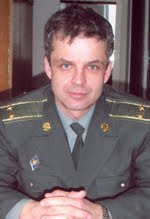The Lower Dnieper Offensive took place in 1943 during the Second World War. It was one of the largest Second World War operations, involving almost 4,000,000 troops on both sides and stretching on a


The Lower Dnieper Offensive took place in 1943 during the Second World War. It was one of the largest Second World War operations, involving almost 4,000,000 troops on both sides and stretching on a

Posted by Oleg Bezverkhnii at 00:34 0 comments
 KYIV, May 23, 2011 (UKRINFORM). The opening ceremony of the Ukrainian-Russian naval exercise Fairway of Peace 2011 was held in Sevastopol (southern Ukraine) Monday, the press service of the Defense Ministry of Ukraine reported. During the exercise, the navies of Ukraine and Russia will work out joint actions during peacekeeping operations in crisis areas. The exercise involves 9 battleships, 8 boats and auxiliary vessels, 8 planes, 3 helicopters, 260 marines of Ukraine's Navy and the Russian Black Sea Fleet, as well as aircraft of the Sevastopol tactical aviation brigade of Ukraine Air Force.
KYIV, May 23, 2011 (UKRINFORM). The opening ceremony of the Ukrainian-Russian naval exercise Fairway of Peace 2011 was held in Sevastopol (southern Ukraine) Monday, the press service of the Defense Ministry of Ukraine reported. During the exercise, the navies of Ukraine and Russia will work out joint actions during peacekeeping operations in crisis areas. The exercise involves 9 battleships, 8 boats and auxiliary vessels, 8 planes, 3 helicopters, 260 marines of Ukraine's Navy and the Russian Black Sea Fleet, as well as aircraft of the Sevastopol tactical aviation brigade of Ukraine Air Force.Posted by Oleg Bezverkhnii at 17:55 0 comments


Posted by Oleg Bezverkhnii at 22:00 0 comments

Posted by Oleg Bezverkhnii at 13:46 0 comments
Modern armament shown to the publick during the 2011 Moscow Victory Day Parade.
1. The T-90 third-generation main battle tank
2. The MSTA-S 152-mm Self-Propelled Howitzer
3. The BUK M2 self-propelled, medium-range surface-to-air missile system
4. The Smerch (Tornado) volley-fire rocket system
5. The S-400 Triumf new generation anti-aircraft weapon system
6. The Pantsir-S1 combined short to medium range surface-to-air missile and anti-aircraft artillery weapon system
7. The 9K720 Iskander mobile theatre ballistic missile system
8. The RT-2UTTKh Topol-M intercontinental ballistic missile
Posted by Oleg Bezverkhnii at 22:51 0 comments
The Russian army Moscow Military Victory Parade of 2011 was held the 09 May 2011. Victory Day marks Germany’s surrender to the Soviet Union in 1945. It became the end of the Great Patriotic War for the USSR, which lost about 25 million citizens in the four years of fighting. Interestingly, until its 20th anniversary (May 9, 1965), Victory Day was not a major holiday, unlike, for instance, May 1, and was considered a work day. Apart from the anniversaries in 1965 and 1985, Victory Day celebrations in the Soviet Union did not feature a military parade. This tradition started in 1995. The biggest military parade is in Moscow’s Red Square, showcasing Russia’s military forces and equipment with aircraft, helicopters, tanks, missile systems and more. Most veterans wear their medals as they head to the parade or an event organized by a local veteran organization.
No military parade on Victory Day in Kyiv this year. The capital of Ukraine hosted a festive procession, a ceremony and a theatrical event to mark the Victory Day.
Posted by Oleg Bezverkhnii at 11:34 0 comments

Posted by Oleg Bezverkhnii at 10:44 0 comments
Posted by Oleg Bezverkhnii at 22:57 0 comments